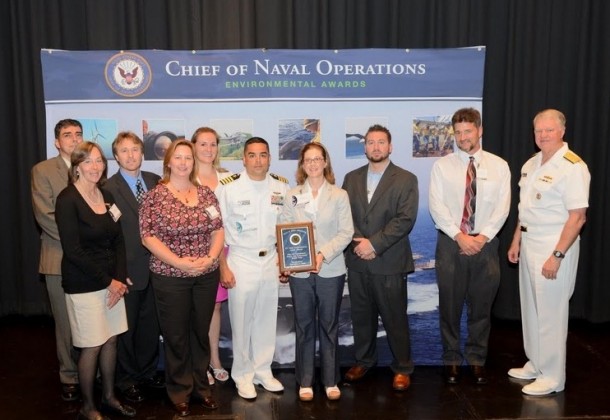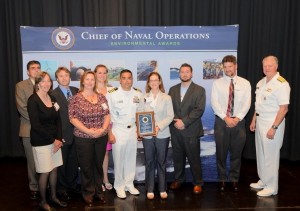Hawkeye Team Wins CNO Award

By PEO(T) Public Affairs
The Environment, Safety and Occupational Health (ESOH) team from the Hawkeye and Greyhound program office, PMA-231, at the Patuxent River Naval Air Station received the fiscal year 2010 Chief of Naval Operations Environmental Award for Sustainability during a ceremony June 7 in Washington, D.C.

Chief of Naval Operations, Adm. Gary Roughead, presents the Environment, Safety and Occupational Health (ESOH) team from the Hawkeye and Greyhound program office, PMA-231, here the fiscal year 2010 Chief of Naval Operations Environmental Award for Sustainability during a ceremony June 7 in Washington, D.C. (U.S. Navy Photo)
The annual award recognizes exceptional environmental stewardship by Navy ships, installations and people.
“Bravo Zulu to all award winners, and to the many other nominees,” said Vice Adm. William R. Burke, deputy chief of naval operations for Fleet Readiness and Logistics, the Pentagon. “You exemplify the Navy’s steadfast commitment to protecting and sustaining the natural environment as a global force for good.”
According to the citation, the team was nominated and subsequently selected because of its leadership during the implementation of new solutions to decades-old problems that include the replacement of hazardous primers, adhesives and Halon, the creation of an E-2 HAZMAT database and improving energy conservation.
The primer used on E-2 aircraft contained hexavalent chromium, which is used in paints and primers for its anti-corrosion effects. Prolonged exposure to this material may cause respiratory and skin damage. To prevent exposure to hexavalent chromium, workers used protective materials that caused almost 31,000 pounds of paint related waste per year, including masking materials, rags and water.
In an effort to lessen environmental effects, the team worked to introduce a new, more environmentally friendly primer.
A non-chromate primer is currently being tested on four E-2C aircraft currently on carrier deployments. Before the primer can be used on all E-2C fleet aircraft, it has to be tested on at least two carrier deployments and perform equal or better than the original primer. The first aircraft being tested are expected to return from the deployment by the end of 2011.
E-2s used both a film and a liquid adhesive that contained formaldehyde and toluene which, according to the U.S. Department of Health and Human Services, causes negative health side. An annual use of 3,000-square-feet of film adhesive that contained formaldehyde and 200-gallons of liquid adhesive that contained toluene were eliminated by switching to a non-hazardous adhesive material.
Halon has been used by the Navy since the late 1970s as a fire suppression system. It is considered an ozone depleting substance and has been replaced with the environmentally acceptable fire suppressant, HFC-125. E-2D Advanced Hawkeye aircraft AA-3 was the first E-2D to be implemented with the new material and eventually, 73 of the 75 E-2D Advanced Hawkeye aircraft will be equipped with HFC-125.
Documentation of hazardous material components has been improved by combining legacy E-2C data with current E-2D Advanced Hawkeye data in the Hazardous Materials Management Program Database, which led to an increase in data by 56 percent. This database allows for quick and accurate searches of information including material, material weights, part numbers and Material Safety Data Sheet’s associated with each HAZMAT.
Energy consumption was reduced by 6.4 million kilowatts at the St. Augustine Manufacturing Center, the E-2D assembly site, by using smart building management systems, building temperature regulation and using more efficient lighting sources. PMA-231 was one of three nominees for the sustainability category.
“The ESOH team will continue to monitor the state-of-the-art in green materials technology development and regulatory forecasting and requirements,” said Erin Beck, E-2D Advanced Hawkeye ESOH coordinator.
“It is a privilege for this program office, and in particular for the ESOH team, to receive such a high honor,” said Capt. Shane Gahagan, Hawekeye/Greyhound program manager. “It is a testament to our continued dedication to the Navy’s commitment to environmental compliance, pollution prevention and continuous improvement of the environmental management system.”






















